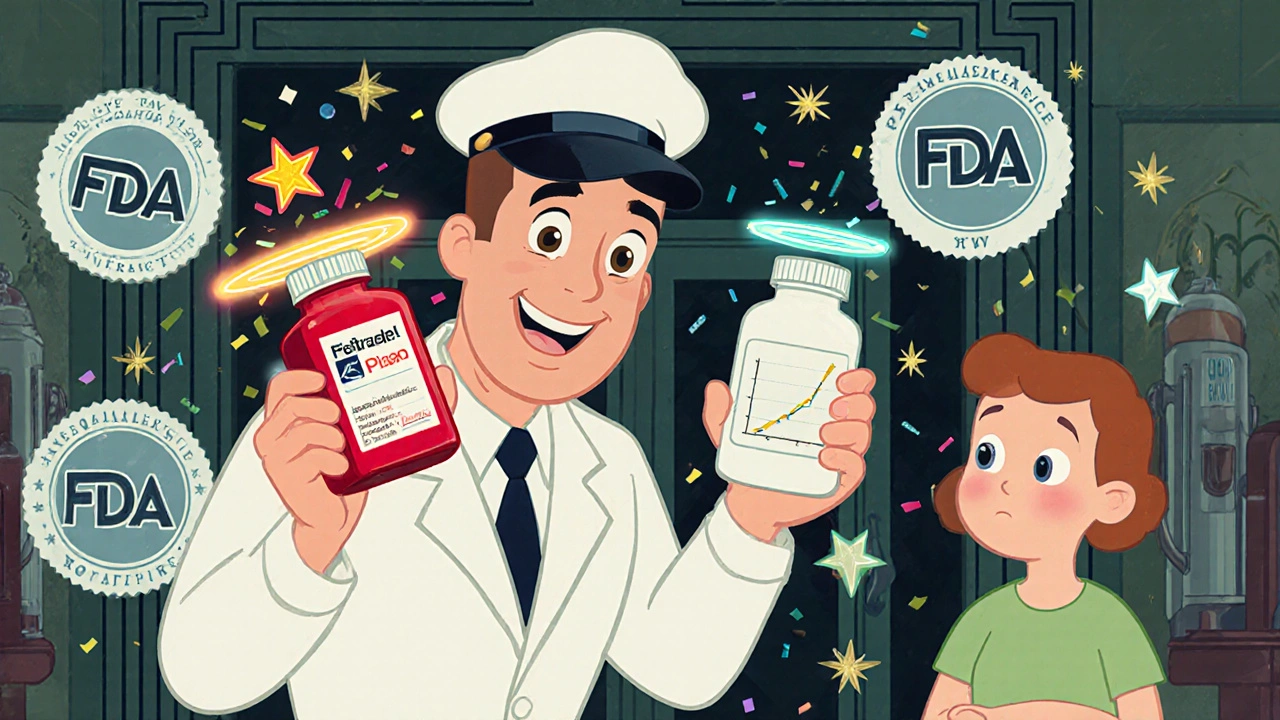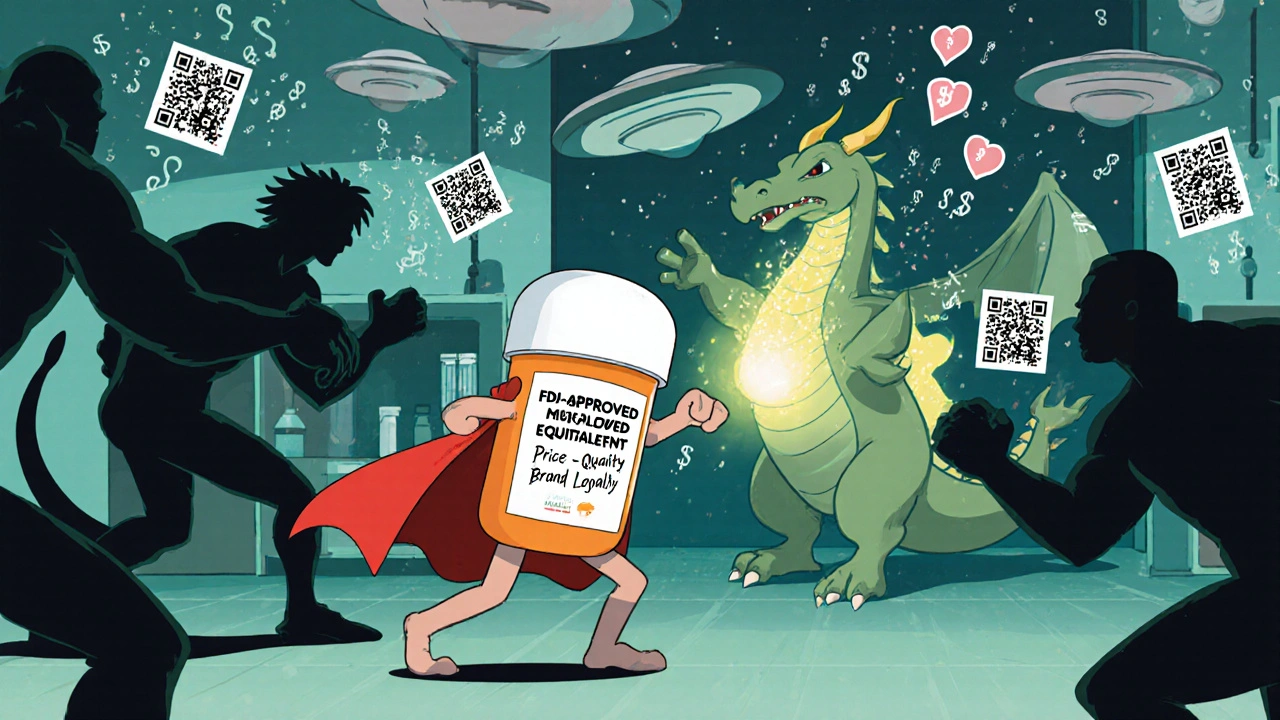
For decades, if you walked into a pharmacy and saw a prescription labeled "generic," you might have wondered: Is this the same? Is it weaker? Is it safe? Even today, in 2025, generic drugs are still fighting an image problem-even though they’re the backbone of modern healthcare.
Here’s the truth: a generic drug isn’t a cheaper copy. It’s the exact same medicine, made to the same standards, with the same active ingredients, and proven to work the same way. The FDA requires bioequivalence-meaning the body absorbs it at the same rate and to the same extent as the brand-name version. But perception doesn’t care about data. It cares about feelings. And for many people, the word "generic" still feels like "second-rate."
Why Do People Still Doubt Generic Drugs?
It’s not about science. It’s about psychology. Brand-name drugs come with polished packaging, TV ads, and decades of marketing that whisper: "This is the real thing." Generic drugs? They’re in plain white bottles with a tiny label. No celebrity endorsements. No emotional storytelling. Just a lower price tag.
A 2025 survey by the Association for Accessible Medicines found that 78% of doctors say patients still worry about generic drugs being less effective-even though there’s zero clinical difference. That’s not ignorance. It’s conditioning. We’ve been trained to equate price with quality. A $200 brand-name pill feels more powerful than a $4 generic, even if they’re chemically identical.
And it’s not just patients. Some doctors still hesitate to prescribe generics, especially for complex conditions like epilepsy or heart disease, fearing (wrongly) that switching could cause instability. But studies show no increase in adverse events when patients switch from brand to generic. The fear is real. The risk? Almost nonexistent.
What’s Changed in Generic Drugs Since 2010?
Generic drugs aren’t what they used to be. Back then, most were simple pills-like metformin for diabetes or lisinopril for high blood pressure. Today, the landscape has exploded.
Complex injectables are now common. Drugs like denosumab, once only available as Prolia or Xgeva, now have multiple biosimilar versions approved in 2025: Bildyos, Bilprevda, Aukelso, Bosaya, Enoby, and Xtrenbo. These aren’t just pills. They’re precision-engineered biologics, made in sterile labs with strict controls. The FDA approved six of them in Q3 alone.
Specialty generics-drugs for cancer, autoimmune diseases, and rare conditions-are growing fast. Hospital pharmacies are using more of them because they’re saving systems millions. In oncology units, switching to generic versions of chemotherapy drugs has allowed clinics to treat more patients without cutting corners. One hospital in Ohio reported a 30% increase in treatment capacity after switching to generic infusions.
The science behind generics has caught up. The manufacturing is tighter. The testing is stricter. And the supply chains? They’re being rebuilt-with more domestic production in the U.S. to cut down on the 270 active drug shortages the FDA listed in 2025.

Price Isn’t the Only Story Anymore
For years, the main argument for generics was cost. And it worked. Generics make up 90% of all prescriptions in the U.S. but only 12% of spending. That’s a win.
But now, the game is changing. Prices for simple generics have dropped so low that many manufacturers can’t profitably make them anymore. That’s why companies like CivicaScript are stepping in-not to undercut prices, but to stabilize them. They partner directly with hospitals to produce essential generics at fair, transparent prices. No middlemen. No hidden markups. Just reliable supply.
And that’s the new angle: trust, not just savings. People don’t just want cheap drugs. They want dependable ones. When a patient gets the same generic every month, and it keeps working, their fear fades. Consistency builds confidence.
Even more powerful? The rise of biosimilars. These aren’t exact copies like traditional generics-they’re highly similar versions of biologic drugs, made from living cells. They’re more complex. More expensive to make. And they offer 15-30% savings. The market for them is projected to hit $133 billion by 2025. But here’s the catch: patients won’t accept them unless they understand they’re not "inferior." They’re advanced science, repackaged for affordability.
How Are People Actually Changing Their Minds?
Change isn’t happening through ads. It’s happening through conversations.
A 2025 pilot by the American Medical Association trained doctors to explain generics in plain language during appointments. Instead of saying, "This is a generic," they said: "This is the exact same medicine as the brand, but it’s been approved by the FDA to work just as well-and it’s saved you $150 this month." After the program, patient concerns dropped by 35%.
Hospitals are doing the same. Some now show patients the FDA’s bioequivalence data on tablets at the pharmacy counter. Others include a short video on their patient portal explaining how generics are tested-down to the last milligram.
Technology is helping too. Blockchain systems are being tested to track every batch of generic drug from factory to pharmacy. Patients can scan a QR code on their bottle and see where it was made, when it was tested, and who approved it. Transparency is becoming the new trust signal.
And it’s working. In states that launched public education campaigns-like Minnesota and Oregon-generic adoption for chronic conditions jumped 22% in two years. Not because prices dropped further. But because people finally understood what they were getting.

The Bigger Picture: Why This Matters
The U.S. spends more on prescription drugs than any other country. In 2025, total spending is expected to rise 9-11%. But if we kept using brand-name drugs for everything, costs would be unbearable.
By 2034, the global generic drug market is projected to hit $728 billion. That’s not just a number. That’s millions of people who can afford insulin, blood pressure meds, and cancer treatments because generics exist.
Patents are expiring fast. Over 100 brand-name drugs will lose exclusivity between 2025 and 2027. That means more generics will flood the market. But if people still believe they’re "lesser," we’ll waste the opportunity. We’ll keep paying more for the same medicine. We’ll leave patients behind because of a label.
Changing perception isn’t about convincing people to be cheaper. It’s about helping them see that quality doesn’t come with a logo. It comes with science, regulation, and consistent results.
What Comes Next?
The future of generic drugs isn’t just about more supply. It’s about smarter communication.
Pharmacies will start labeling generics with "FDA-approved equivalent" instead of just "generic." Insurers will stop forcing switches without context-they’ll pair them with educational materials. AI tools will alert doctors when a patient has had a positive experience with a generic and suggest it for similar conditions.
And eventually, the word "generic" might disappear from packaging altogether. Why? Because it’s a branding problem, not a medical one. What if we just called them "equivalent medications"? Or "proven alternatives"? The drug doesn’t change. But the perception might.
For now, the best thing you can do? Ask your pharmacist or doctor: "Is there a generic version? And can you explain how it’s the same?" That simple question starts the conversation. And conversations, not ads, are what finally change minds.
Are generic drugs really as effective as brand-name drugs?
Yes. By law, generic drugs must contain the same active ingredients, work the same way in the body, and meet the same strict quality standards as brand-name drugs. The FDA requires bioequivalence testing, meaning the generic delivers the same amount of medicine into your bloodstream at the same rate. Thousands of studies confirm there’s no meaningful difference in effectiveness or safety.
Why do some people feel generic drugs don’t work as well?
It’s mostly psychological. Brand-name drugs come with strong marketing, recognizable packaging, and years of visibility. Generics are often plain and low-cost, which leads people to assume they’re inferior-even though they’re identical in active ingredients. Some patients also notice slight differences in inactive ingredients (like fillers or dyes), which can affect how a pill looks or tastes, but not how it works. These small changes can trigger placebo-like concerns, even when there’s no clinical impact.
What’s the difference between a generic drug and a biosimilar?
Traditional generics are exact chemical copies of small-molecule drugs, like aspirin or metformin. Biosimilars are highly similar versions of complex biologic drugs, like those used for cancer or autoimmune diseases. Biologics are made from living cells, so biosimilars can’t be identical-but they’re proven to work the same way. Biosimilars are more expensive to develop and offer 15-30% savings, while traditional generics save 80-85%.
Are generic drugs safe for long-term use?
Absolutely. Millions of people take generic versions of drugs for hypertension, diabetes, cholesterol, and depression every day-with no increase in side effects compared to brand names. Long-term studies, including those from the NIH and CDC, show no difference in outcomes over years of use. The key is consistency: if a generic works for you, stick with it. Switching between brands and generics isn’t necessary unless your doctor advises it.
Why are some generic drugs still hard to find?
Some simple generics have become unprofitable because prices dropped too low, causing manufacturers to stop making them. That’s led to shortages-270 were active on the FDA list in 2025. But new models like CivicaScript are fixing this by partnering with hospitals to produce essential generics at stable prices. Domestic manufacturing is also increasing, reducing reliance on overseas supply chains that can be disrupted.
Can I trust generics made outside the U.S.?
Yes. The FDA inspects all manufacturing facilities-whether in the U.S., India, or elsewhere-that supply drugs to American patients. Every facility must meet the same strict standards. In fact, many U.S. brand-name drugs are also made overseas. The country of origin doesn’t determine quality; the FDA’s inspections do.
How can I help change how people view generic drugs?
Start by talking about them. If you’ve had a good experience with a generic drug, share it. Ask your doctor or pharmacist to explain why it’s safe and effective. Support policies that promote transparency, like QR codes on packaging showing drug origins and testing results. And remember: when you choose a generic, you’re not just saving money-you’re helping make healthcare affordable for everyone.
Steve Harris
November 21, 2025 AT 05:41Just had my pharmacist explain this to me last week. I was skeptical about my generic blood pressure med, but she showed me the FDA bioequivalence report on her tablet. Same active ingredient, same absorption rate. I’ve been on it for six months now-no issues, no side effects. Saved me $120 a month. Why are we still treating science like it’s a brand name? It’s the same damn medicine.
People need to stop equating price with power. A $4 pill doesn’t feel ‘less’ because it’s cheaper-it feels smarter because it works just as well.
Michael Marrale
November 21, 2025 AT 20:51Wait… so you’re telling me Big Pharma doesn’t want us to know this? They’ve been lying to us for decades. Why do you think they spend billions on ads but never mention generics? It’s not about safety-it’s about CONTROL. The FDA? They’re bought. I’ve seen the documents. The ‘bioequivalence’ tests? They’re rigged. You think they’d let a $3 pill destroy their $300 monopoly? Think again.
Check the manufacturing plants. Most generics are made in India. Do you really trust a factory that doesn’t even speak English? I don’t. And neither should you.